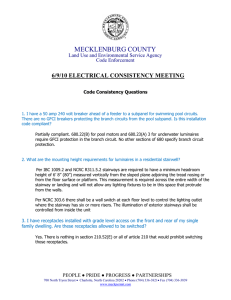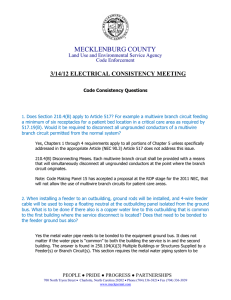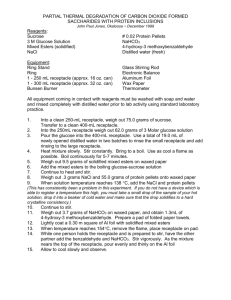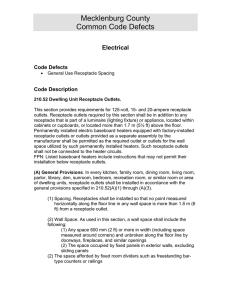MECKLENBURG COUNTY 7/14/10 ELECTRICAL CONSISTENCY MEETING Land Use and Environmental Service Agency
advertisement
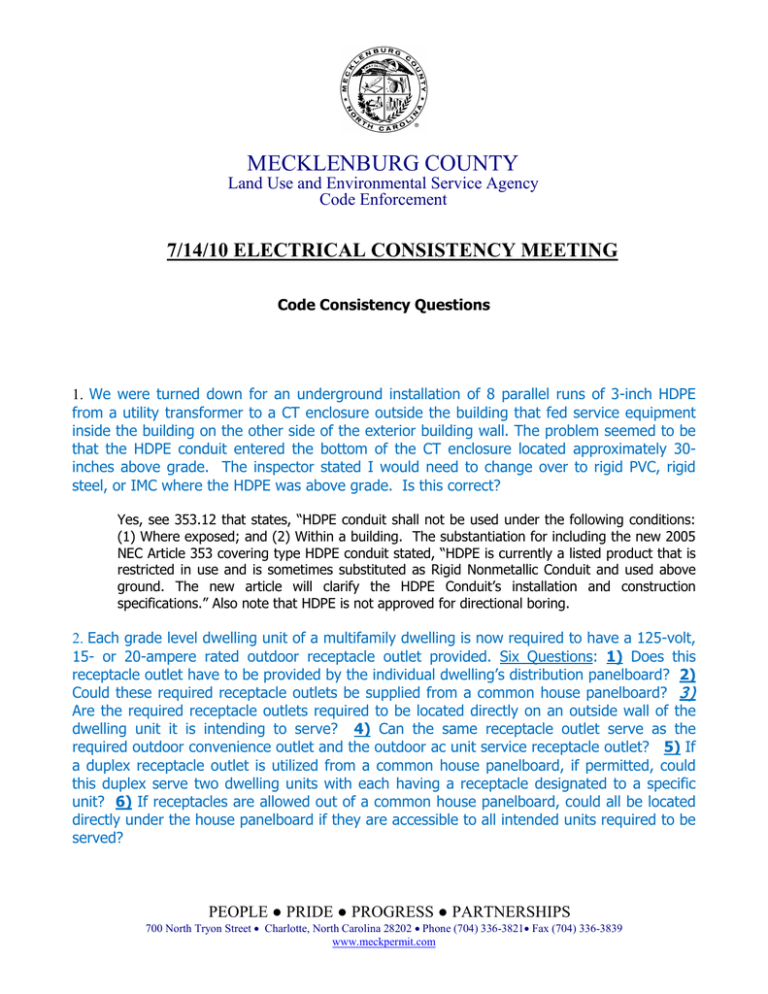
MECKLENBURG COUNTY Land Use and Environmental Service Agency Code Enforcement 7/14/10 ELECTRICAL CONSISTENCY MEETING Code Consistency Questions 1. We were turned down for an underground installation of 8 parallel runs of 3-inch HDPE from a utility transformer to a CT enclosure outside the building that fed service equipment inside the building on the other side of the exterior building wall. The problem seemed to be that the HDPE conduit entered the bottom of the CT enclosure located approximately 30inches above grade. The inspector stated I would need to change over to rigid PVC, rigid steel, or IMC where the HDPE was above grade. Is this correct? Yes, see 353.12 that states, “HDPE conduit shall not be used under the following conditions: (1) Where exposed; and (2) Within a building. The substantiation for including the new 2005 NEC Article 353 covering type HDPE conduit stated, “HDPE is currently a listed product that is restricted in use and is sometimes substituted as Rigid Nonmetallic Conduit and used above ground. The new article will clarify the HDPE Conduit’s installation and construction specifications.” Also note that HDPE is not approved for directional boring. 2. Each grade level dwelling unit of a multifamily dwelling is now required to have a 125-volt, 15- or 20-ampere rated outdoor receptacle outlet provided. Six Questions: 1) Does this receptacle outlet have to be provided by the individual dwelling’s distribution panelboard? 2) Could these required receptacle outlets be supplied from a common house panelboard? 3) Are the required receptacle outlets required to be located directly on an outside wall of the dwelling unit it is intending to serve? 4) Can the same receptacle outlet serve as the required outdoor convenience outlet and the outdoor ac unit service receptacle outlet? 5) If a duplex receptacle outlet is utilized from a common house panelboard, if permitted, could this duplex serve two dwelling units with each having a receptacle designated to a specific unit? 6) If receptacles are allowed out of a common house panelboard, could all be located directly under the house panelboard if they are accessible to all intended units required to be served? PEOPLE ● PRIDE ● PROGRESS ● PARTNERSHIPS 700 North Tryon Street • Charlotte, North Carolina 28202 • Phone (704) 336-3821• Fax (704) 336-3839 www.meckpermit.com Page 2 of 9 1) See 210.25 & 240.24(B). No. The receptacle could be supplied from a panelboard other than the one in the dwelling. However the occupant has to have access to the overcurrent protective device supplying that branch circuit. 2) See 210.25 & 240.24(B). Yes. The code does not specify where the circuits are to be supplied from; only that the branch circuits cannot supplying one dwelling unit cannot supply another dwelling unit. Access to that panelboard is required. 3) See 210.52(E). It is intended by the requirement for multifamily units that a receptacle be installed on the outside of each dwelling unit located at grade and having direct exit to, and entrance from, the outside. 4) See 210.52(E) and 210.63. Yes. It can serve as the outdoor receptacle outlet and the service receptacle outlet if located within 25 feet of the A/C unit. 5) See 210.52(E). No. Section 210.52 (E) requires the installation of at least one receptacle outlet for each dwelling. The definition of receptacle outlet is “An outlet where one or more receptacles are installed. The question suggests splitting a duplex receptacle but by definition, the duplex receptacle is located at a single receptacle outlet and the intent has not been met. 6) No. See 210.52(E) and 110.2. The purpose of this requirement is to provide an accessible receptacle outlet on the exterior of each grade level dwelling unit in order that the occupant can use outdoor electrical equipment directly outside his unit. The suggested location would only promote the use of extension cords and the connection of cords (run through doors and windows) to receptacle outlets inside the dwelling that may not have GFCI protection. 3. A one-family dwelling must have a service disconnecting means rated not less than 100 amperes. However, is it permissible to place 70-ampere fuses in the 100-ampere rated service disconnect and feed this dwelling with 6 AWG copper conductors if this meets the computed load? See 230.42(B), 230.79(C), 230.90 Exception No. 5, and Table 310.15(B)(6). In accordance with 230.42 (B) the minimum ampacity for ungrounded conductors for specific installations shall not be less than the rating of the service disconnecting means specified in 230.79 (A) through (D). Therefore the minimum size conductors in accordance with Table 310.15(B)(6) for a 120/240 volt, single phase dwelling service rated at 100 amperes is 4 AWG copper or 2 AWG aluminum. The rating of the service overload protection device is permitted to be based on 310.15(B)(6) and shall not be less than is required to serve the calculated load. If the 70 ampere fuses are sufficient to carry the calculated load, their installation in the 100 ampere disconnecting means is permitted. 4. A dwelling property has an outdoor 125-volt, 15-ampere receptacle installed on a detached garage located 10' from the back of the dwelling unit in the back yard. Could this receptacle PEOPLE ● PRIDE ● PROGRESS ● PARTNERSHIPS 700 North Tryon Street • Charlotte, North Carolina 28202 • Phone (704) 336-3821• Fax (704) 336-3839 www.meckpermit.com Page 3 of 9 serve as the required rear outdoor receptacle outlet per 210.52(E)? See 210.52(E). No. Section 210.52(E) requires an outdoor receptacle outlet to be installed at the front and back of the dwelling. Actual Code text in 210.52(E) in part: “at least one receptacle outlet accessible at grade level and not more than 2.0 m (6 1/ 2 ft) above grade shall be installed at the front and back of the dwelling.” The question creates a scenario that is going to require a determination by the approving authority (AHJ). In my opinion, based on the information provided in the question, there is a receptacle installed at the back of the dwelling and it could meet the minimum requirements of the NEC and also satisfy the objective of the rule. The Code does not require this receptacle outlet to be installed on the dwelling unit; it just has to be installed at the back of the unit. The information in the question indicates it is installed within 10 feet of the back of the dwelling unit. In Mecklenburg County we say the receptacle may be on the unit or within 6 ½ feet off the unit. Also, 210.52(E) requires each dwelling unit of a multifamily dwelling where the dwelling unit is located at grade level and provided with individual exterior entrance/egress, at least one receptacle outlet accessible from grade level and not more than 2.0 m (6-½ ft) above grade shall be installed. Also see 210.8(A)(3) for GFCI requirements. 5. A recent inspection found hospital grade Type AC cable being used to supply dentists chair stations in a large room with only 4-foot high partitions separating each cubical dentist area. The AC cable was installed in a PVC conduit run underground beneath an on grade concrete slab. I turned this installation down as AC cable is not permitted in damp or wet locations, but the contractor stated the AC cable was now a part of a raceway wiring method and was no longer considered a cable wiring method as the cable terminated in boxes at each end of the runs of PVC conduit and that the AC cable conductors were marked THWN. The contractor also pointed out 352.22 states that cables shall be permitted to be installed where such use in not prohibited by the respective cable article and Article 320 does not prohibit such an installation. Please comment. Type AC cable is not permitted for this application. This is a wet location as defined in Article 100. Armored cable is a dry location wiring method regardless of the conductor insulation. 6. Question is about an installation of MC cable that contains three 250 kcmil aluminum phase conductors and one 2/0 AWG aluminum grounding conductor where one of the black insulated 250 kcmil conductors is re-identified with a circle of white tape as a grounded conductor for a 3-wire, 120/240-volt single phase feeder with equipment-ground. This installation was rejected with the inspector citing 200.6(E). He also stated that if this installation had been the same conductors but in a raceway wiring method the installation PEOPLE ● PRIDE ● PROGRESS ● PARTNERSHIPS 700 North Tryon Street • Charlotte, North Carolina 28202 • Phone (704) 336-3821• Fax (704) 336-3839 www.meckpermit.com Page 4 of 9 would have been Code compliant. What is the reason for this “special” rule for cables? The inspector is right. 200.6(B) does not have the stipulation like 200.6(E) “Where the conditions of maintenance and supervision ensure that only qualified persons service the installation” grounded conductors shall be permitted to be permanently identified at their termination at the time of installation….. Code Reference 200.6 (B) Sizes Larger Than 6 AWG An insulated grounded conductor larger than 6 AWG shall be identified by one of the following means: (1) By a continuous white or gray outer finish. (2) By three continuous white stripes along its entire length on other than green insulation. (3) At the time of installation, by a distinctive white or gray marking at its terminations. This marking shall encircle the conductor or insulation. 200.6 (E) Grounded Conductors of Multiconductor Cables The insulated grounded conductors in a multiconductor cable shall be identified by a continuous white or gray outer finish or by three continuous white stripes on other than green insulation along its entire length. Multiconductor flat cable 4 AWG or larger shall be permitted to employ an external ridge on the grounded conductor. Exception No. 1: Where the conditions of maintenance and supervision ensure that only qualified persons service the installation, grounded conductors in multiconductor cables shall be permitted to be permanently identified at their terminations at the time of installation by a distinctive white marking or other equally effective means. 7. 700.27 requires emergency system(s) overcurrent devices to be selectively coordinated with all supply side overcurrent protective devices. How is this to be accomplished and what can an AHJ do to make sure the installer complies with this requirement? See Article 100: Coordination (selective), 110.3(B), and 700.27. Design and subsequent verification of electrical system coordination can be achieved only through a coordination study by the design engineer or consultant that entails detailed knowledge of electrical supply system fault current characteristics. For selective coordination of overcurrent protective devices, the manufacturer's timecurrent curves, let-through and withstand capacity data, and unlatching times data must be used for sizing or setting overcurrent devices. The overcurrent protective devices specified for the system must be verified by the AHJ that they are of the correct type and size according to the design specifications for the system. Note: Michael Johnston, IAEI, from the audience, ask the panelist answering the PEOPLE ● PRIDE ● PROGRESS ● PARTNERSHIPS 700 North Tryon Street • Charlotte, North Carolina 28202 • Phone (704) 336-3821• Fax (704) 336-3839 www.meckpermit.com Page 5 of 9 question how a series rated system would react in a selectively coordinated installation. Answer: It will not work with a series rated system as both overcurrent devices will open and this would not serve as a selectively coordinated system. Panel 13 and Panel 15 understand the effect of series rated systems and their potential effect on emergency and critical branch systems as you are losing the reliability of the system required in specific environments and it is hoped that designers will not make any moves that will put life safety at risk. 8. The feeder from the secondary of a 480-120/208-volt, 3-phase, 112.5 KVA transformer is installed with 500 kcmil phase and grounded conductor ending in a 400 amp main breaker panelboard. The transformer is protected on the primary at 150 amps. Is this a code violation and if so, why? See 240.21(B), 240.21(C), 110.14(C) and Table 310.16. No. The transformer is correctly protected with primary only protection with the 150-ampere primary breaker per Table 450.3(B). Per the UL White Book the terminations in dry type transformers are rated for 75º C and in accordance with 110.14(C)(2) the minimum insulation temperature for terminating in the 400-ampere circuit breaker is also 75º C. In accordance with Table 310.16, the 75º C ampacity for 500 kcmil is 380 amperes. A change in the 2005 NEC clarified that the conductor ampacity requirement in the tap conductor and transformer secondary conductor requirements cannot be achieved through the use of the next standard size permission in 240.4(B). Therefore the conductor protection required under 240.21(C) has not been met and a conductor with an allowable ampacity of not less than 400-amperes shall be used. 9. Could we go over Mecklenburg’s stand on 250.104 (B) and (C) as applied to houses where copper is being used...not track pipe. I am having an issue with a neighboring county and just wanted to know your stand on bonding at the gas meter. The key words in both 250.104 (B) and (C) is “subject to become energized” and “shall be bonded”. In the case of (B) typically the electrical appliance being fed by the gas piping system is fed with an equipment grounding conductor and thus (B) is satisfied. For (C), a judgment will have to be made as to the proximity of live conductors to structural metal (subject to be energized) and then bonding done accordingly per the section. PEOPLE ● PRIDE ● PROGRESS ● PARTNERSHIPS 700 North Tryon Street • Charlotte, North Carolina 28202 • Phone (704) 336-3821• Fax (704) 336-3839 www.meckpermit.com Page 6 of 9 10. Are lights required in attic storage of detached garages and carports? Yes, Per 210.70 (A), (2) & (3) (2) Additional Locations. Additional lighting outlets shall be installed in accordance with (A) (2)(a), (A)(2)(b), and (A)(2)(c). (a) At least one wall switch–controlled lighting outlet shall be installed in hallways, stairways, attached garages, and detached garages with electric power. (b) For dwelling units, attached garages, and detached garages with electric power, at least one wall switch–controlled lighting outlet shall be installed to provide illumination on the exterior side of outdoor entrances or exits with grade level access. A vehicle door in a garage shall not be considered as an outdoor entrance or exit. (c) Where one or more lighting outlet(s) are installed for interior stairways, there shall be a wall switch at each floor level, and landing level that includes an entryway, to control the lighting outlet(s) where the stairway between floor levels has six risers or more. Exception to (A)(2)(a), (A)(2)(b), and (A)(2)(c): In hallways, in stairways, and at outdoor entrances, remote, central, or automatic control of lighting shall be permitted. (3) Storage or Equipment Spaces. For attics, underfloor spaces, utility rooms, and basements, at least one lighting outlet containing a switch or controlled by a wall switch shall be installed where these spaces are used for storage or contain equipment requiring servicing. At least one point of control shall be at the usual point of entry to these spaces. The lighting outlet shall be provided at or near the equipment requiring servicing. SUBJECT: Attic / Storage Light CODE REFERENCE: 210.70 (A) (3) SUBMITTED BY: Electrical Contractor EFFECTIVE DATE: Immediately PROBLEM: When is a light required in an attic storage area? SOLUTION: Attic spaces of less than six feet (6’), in depth or height, shall not be considered as attic storage requiring a lighting outlet. APPROVED BY: GERALD HARVELL ELECTRICAL CPM FEB/2006 PEOPLE ● PRIDE ● PROGRESS ● PARTNERSHIPS 700 North Tryon Street • Charlotte, North Carolina 28202 • Phone (704) 336-3821• Fax (704) 336-3839 www.meckpermit.com Page 7 of 9 8.4 11. What are the receptacle spacing requirements when there are cabinets/shelves floor to ceiling in rooms such as a study or library. 210.52 Dwelling Unit Receptacle Outlets. This section provides requirements for 125-volt, 15- and 20-ampere receptacle outlets. The receptacles required by this section shall be in addition to any receptacle that is: (1) Part of a luminaire or appliance, or (2) Controlled by a wall switch in accordance with 210.70(A)(1), Exception No. 1, or (3) Located within cabinets or cupboards, or (4) Located more than 1.7 m (5½ ft) above the floor Permanently installed electric baseboard heaters equipped with factory-installed receptacle outlets or outlets provided as a separate assembly by the manufacturer shall be permitted as the required outlet or outlets for the wall space utilized by such permanently installed heaters. Such receptacle outlets shall not be connected to the heater circuits. FPN: Listed baseboard heaters include instructions that may not permit their installation below receptacle outlets. (A) General Provisions. In every kitchen, family room, dining room, living room, parlor, library, den, sunroom, bedroom, recreation room, or similar room or area of dwelling units, receptacle outlets shall be installed in accordance with the general provisions specified in 210.52(A)(1) through (A)(3). (1) Spacing. Receptacles shall be installed such that no point measured horizontally along the floor line in any wall space is more than 1.8 m (6 ft) from a receptacle outlet. (2) Wall Space. As used in this section, a wall space shall include the following: (1) Any space 600 mm (2 ft) or more in width (including space measured around corners) and unbroken along the floor line by doorways, fireplaces, and similar openings (2) The space occupied by fixed panels in exterior walls, excluding sliding panels (3) The space afforded by fixed room dividers such as freestanding bar-type counters or railings When there are floor-to-ceiling cabinets with operable doors receptacle spacing requirements begin beyond these cabinets. If cabinets are installed in half walls, receptacle spacing will be PEOPLE ● PRIDE ● PROGRESS ● PARTNERSHIPS 700 North Tryon Street • Charlotte, North Carolina 28202 • Phone (704) 336-3821• Fax (704) 336-3839 www.meckpermit.com Page 8 of 9 required above the cabinets. Normal receptacle spacing is required in areas where bookshelves are installed. (Ceiling) (Floor) The examples above would be included in receptacle spacing requirements PEOPLE ● PRIDE ● PROGRESS ● PARTNERSHIPS 700 North Tryon Street • Charlotte, North Carolina 28202 • Phone (704) 336-3821• Fax (704) 336-3839 www.meckpermit.com Page 9 of 9 The example below would be excluded from receptacle spacing requirements (Ceiling) ( Floor) PEOPLE ● PRIDE ● PROGRESS ● PARTNERSHIPS 700 North Tryon Street • Charlotte, North Carolina 28202 • Phone (704) 336-3821• Fax (704) 336-3839 www.meckpermit.com

